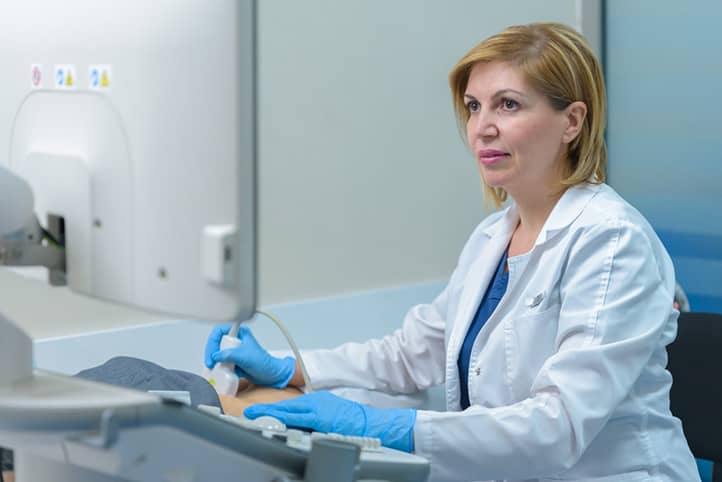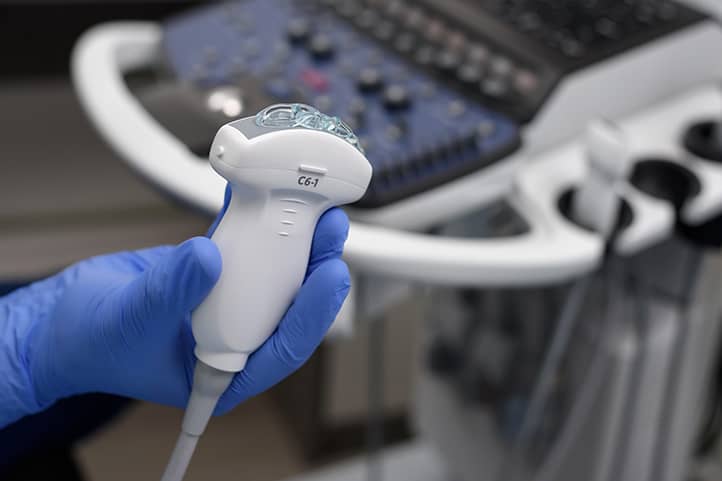Psychosomatics is the study of the connection between a person’s mental and physical states. Often, stress, emotional overload, and other psychological factors lead to physical illnesses. Modern medicine offers new diagnostic methods that help reveal these connections. One such method is ultrasound diagnostics, which not only detects physical problems but also unveils psychosomatic aspects.

Basics of Psychosomatics
Psychosomatics studies the connection between a person’s mental state and physical illnesses, emphasizing the influence of emotions, stress, and psychological factors on the body. This approach requires a comprehensive view, as disorders can have both mental and physical symptoms. Understanding these connections helps doctors and patients identify the true causes of illnesses and find effective treatment methods.
Psychosomatic illnesses often manifest through symptoms that cannot be explained solely by physical causes. For instance, patients may suffer from chronic pain or digestive issues that do not respond to conventional medical treatment. Recognizing how emotional states affect the body allows for a personalized treatment approach for each patient.
Emotions such as fear, anger, joy, or sadness have a direct impact on physiological processes. For example, during stress, the sympathetic nervous system is activated, leading to increased heart rate, elevated blood pressure, and muscle tension. These reactions can become chronic if the stress persists for an extended period, ultimately resulting in serious illnesses.
Understanding psychosomatics is also essential for disease prevention. Early detection and management of stress, along with psychotherapeutic support, help prevent the development of chronic diseases. This approach to health requires the collaboration of doctors from various specialties, including psychologists, psychotherapists and psychiatrists, to provide comprehensive assistance to patients.
Psychosomatic Disorders: Definition and Examples
Psychosomatic disorders are illnesses that arise from the influence of psychological factors on a person’s physical condition. Examples of such disorders include:
- hypertension;
- stomach ulcers;
- irritable bowel syndrome;
- bronchial asthma.
The Mind-Body Connection
The connection between the mind and body has been known since ancient times. Modern research confirms that emotional stress and mental strain can cause physical symptoms and even chronic diseases. For example, prolonged stress can lead to high blood pressure or digestive issues.
How Emotions and Stress Affect Physical Condition
Emotions and stress impact physical health through various mechanisms. For instance, during stress, the body produces hormones like adrenaline and cortisol, which can affect the cardiovascular system, gastrointestinal tract, and other organs. Prolonged stress can lead to chronic illnesses.

Ultrasound Diagnostics: Principles and Capabilities
Ultrasound diagnostics is one of the most popular and safe medical examination methods, using high-frequency sound waves to create images of internal organs. Due to its non-invasive nature and safety, this method is widely used across various fields of medicine. It allows doctors to obtain accurate information about internal organs without the need for surgery.
Ultrasound diagnostics also offers a range of unique capabilities. It enables the assessment of organs in real-time, which is crucial for monitoring disease progression or treatment effectiveness. Additionally, this method can detect abnormalities and pathologies in the early stages, promoting timely treatment and increasing recovery chances.
Technological advancements constantly enhance ultrasound diagnostics, making it even more precise and informative. Modern ultrasound devices have high resolution and can create three-dimensional images, allowing doctors to examine organs and tissues in greater detail. This opens up new possibilities for diagnosing and treating various diseases.
The application of ultrasound diagnostics in medicine is extensive. It is used in cardiology to assess heart health, in obstetrics and gynecology to monitor fetal development and pelvic organ conditions, in gastroenterology for examining abdominal organs, and in many other areas. This versatile tool aids doctors in their daily practice.
Technology Description of Ultrasound Diagnostics
Ultrasound diagnostics is a method for examining internal organs using high-frequency sound waves, allowing the visualization of internal structures in real-time. The ultrasound waves reflect off tissues to create an image analyzed by a doctor.
Applications of Ultrasound in Different Medical Fields
Ultrasound diagnostics is widely used in various medical fields:
- Obstetrics and Gynecology (fetal assessment, gynecological disease diagnosis)
- Cardiology (heart and vascular condition assessment)
- Urology (diagnosis of kidney and bladder diseases)
- Gastroenterology (assessment of liver, gallbladder, and pancreas health)
Advantages and Limitations of Ultrasound Examinations
Ultrasound examinations offer several advantages:
- Safety (absence of ionizing radiation)
- Non-invasiveness
- Real-time imaging capability
However, there are some limitations:
- Inability to penetrate through bone structures.
- Limited resolution compared to other imaging methods (e.g., MRI).

Psychosomatic Aspects in Ultrasound Diagnostics
Ultrasound diagnostics opens new possibilities for understanding the psychosomatic aspects of illnesses. With its ability to detect physical changes in the body, this method helps doctors observe the link between a patient’s mental state and physical health. This is especially important for diagnosing illnesses of a psychosomatic nature.
Physical symptoms caused by mental disorders can often be detected through ultrasound diagnostics. For instance, prolonged stress can cause changes in heart function, which can be identified using echocardiography. Similarly, psycho-emotional issues may impact the gastrointestinal tract, which can be visualized in ultrasound images.
Understanding psychosomatic aspects through ultrasound diagnostics also promotes more accurate diagnosis and treatment of illnesses. Doctors can use ultrasound examination results to identify physical manifestations of mental disorders and develop appropriate therapeutic strategies. This enables a more individualized and comprehensive approach to patient treatment.
Integrating ultrasound diagnostics with psychosomatic medicine opens new horizons for medical science. It not only improves diagnosis and treatment but also deepens our understanding of how mental processes impact physical health. This approach helps doctors more effectively assist their patients, taking into account all aspects of their health.
How Does Ultrasound Help Detect Psychosomatic Disorders?
Ultrasound diagnostics helps detect physical changes caused by psychosomatic disorders. For example, anxiety states may lead to heart function changes, which are identifiable through echocardiography. Stressful situations can affect gastrointestinal function, which can be assessed via ultrasound diagnostics.
Examples of Detecting Physical Manifestations of Mental Disorders via Ultrasound
Here are several examples where ultrasound diagnostics helped identify physical manifestations of mental disorders:
- Patients under stress may experience high blood pressure and left ventricular hypertrophy, detectable through echocardiography.
- Anxiety states may cause intestinal spasms, visible on abdominal ultrasound examinations.
- Chronic stress can lead to changes in liver function, identifiable through ultrasound examinations.
Clinical Cases and Studies Confirming Method Effectiveness
Clinical studies confirm the effectiveness of ultrasound diagnostics in detecting psychosomatic disorders. For instance, research conducted in leading medical centers has shown that ultrasound diagnostics is useful in identifying heart function changes in patients with stress and anxiety disorders.

Techniques and Methods of Ultrasonic Psychodiagnostics
Ultrasonic psychodiagnostics employs specific methods to detect psychosomatic disorders, enabling more accurate diagnosis and treatment of patients. These methods include both standard ultrasound examinations and specialized techniques developed to assess the condition of organs and systems influenced by mental factors.
One of the key techniques in ultrasonic psychodiagnostics is Doppler ultrasound, which allows for the evaluation of blood flow in various organs and tissues. This is particularly useful for detecting changes in the cardiovascular system that may be caused by stress or other mental disorders. Such an approach helps doctors see a comprehensive picture of a patient’s health status.
Another important technique is the use of contrast agents, which enhance the accuracy of ultrasound images. This allows for a more detailed study of organ structure and function, as well as the detection of even minor abnormalities. This technique is especially valuable for diagnosing psychosomatic disorders that may have subtle physical manifestations.
Combining various ultrasound techniques and methods allows for better outcomes in diagnosing psychosomatic disorders. Physicians can use these methods to assess patient conditions, monitor disease dynamics, and evaluate treatment effectiveness. Such a comprehensive approach ensures a high level of medical care and contributes to improving patients’ quality of life.
Specific Techniques for Ultrasonic Diagnosis of Psychosomatic Disorders
Specific ultrasound diagnostic techniques exist that can be useful for identifying psychosomatic disorders. For example, transabdominal ultrasound examination of abdominal organs allows for the detection of changes in gastrointestinal function related to stress.
Interpreting Ultrasound Images in a Psychosomatic Context
Interpreting ultrasound images in a psychosomatic context requires specialized knowledge and experience. The doctor must consider not only physical changes in the body but also possible mental causes for these changes. For instance, detecting spasms in the intestines may indicate psycho-emotional stress in a patient, and this should be taken into account when diagnosing and prescribing treatment.
Comparison with Other Diagnostic Methods
Ultrasound diagnostics have advantages and disadvantages compared to other diagnostic methods, such as magnetic resonance imaging (MRI) and computed tomography (CT). For example, MRI provides more detailed images of soft tissues, but ultrasound is a more accessible and safer method for regular monitoring. CT can be more effective for detecting bone structures, but ultrasound is better suited for real-time assessment of internal organs.

Innovative Research and Discoveries
Modern medicine is constantly evolving, and new research and discoveries are regularly emerging in the field of ultrasound diagnostics. Innovations in this area aim to improve diagnostic accuracy, reduce procedure invasiveness, and expand capabilities for detecting various diseases, including psychosomatic disorders.
One of the most interesting research areas is the development of new ultrasound machines with enhanced technical characteristics. This includes high-frequency sensors, which enable obtaining more detailed images, and new software algorithms for data processing, which improve diagnostic accuracy. These innovations make ultrasound diagnostics even more reliable and effective.
Another important research aspect involves integrating ultrasound technologies with other diagnostic methods. For instance, combining ultrasound diagnostics with magnetic resonance imaging (MRI) or computed tomography (CT) allows for an even more comprehensive view of a patient’s condition. This contributes to the more accurate detection and treatment of diseases, including those with a psychosomatic nature.
Innovative studies also explore new approaches to using ultrasound diagnostics for detecting psychosomatic disorders. This may include the development of new methods for evaluating the functioning of organs and systems most susceptible to the influence of mental factors. Such research has the potential to significantly improve the diagnosis and treatment of psychosomatic diseases.
Overview of Contemporary Research in Ultrasonic Psychodiagnostics
Contemporary research in the field of ultrasonic psychodiagnostics focuses on studying new ways of using ultrasound technology to identify psychosomatic disorders. For example, research has shown that ultrasound is an effective tool for detecting changes in the cardiovascular system caused by chronic stress.
New Approaches and Development Perspectives
New approaches in ultrasound diagnostics include using contrast agents and Doppler ultrasound for a more detailed study of blood circulation and the detection of abnormalities associated with psychosomatic disorders. Development perspectives include the integration of ultrasound diagnostics with other methods, such as neuroimaging, for a comprehensive approach to studying psychosomatic connections.
Potential Discoveries and Impact on Medicine and Psychology
Potential discoveries in the field of ultrasonic psychodiagnostics may have a significant impact on medicine and psychology. For example, the development of new methods and technologies could lead to the more precise identification of psychosomatic disorders and their effective treatment. In turn, this could contribute to an improved quality of life for patients and reduced healthcare costs.

Practical Application and Recommendations
The practical application of ultrasound diagnostics in identifying and treating psychosomatic disorders is an extremely important aspect of modern medicine. Physicians from various specialties can use ultrasound to gather valuable information about a patient’s physical condition and detect physical manifestations of mental disorders. This enables more precise and effective medical care.
One of the main recommendations for patients is regular ultrasound examinations, especially if they suffer from chronic stress or have suspected psychosomatic disorders. Ultrasound helps detect early signs of diseases and start treatment at the initial stages, which increases the chances of successful recovery.
Doctors should also consider psychosomatic aspects when evaluating ultrasound results. This means that physical changes detected via ultrasound may be related to a patient’s mental state. Such an approach allows for the development of individualized treatment plans, including both medical and psychological care.
How Physicians and Psychologists Can Integrate Ultrasound Diagnostics into Their Practice?
Physicians and psychologists can integrate ultrasound diagnostics into their practice by using this method to detect physical changes caused by psychosomatic disorders. For example, ultrasound examination can be helpful for monitoring heart health in patients with chronic stress or for assessing gastrointestinal function in patients with anxiety disorders.
Patient Recommendations: When to Seek Ultrasound Diagnostics
Patients are recommended to seek ultrasound diagnostics in the following cases:
- If they suffer from chronic stress or anxiety disorders.
- If psychosomatic disorders are suspected.
- For monitoring the condition of internal organs in cases of chronic illness.
- To detect physical changes caused by psycho-emotional factors.
The Importance of a Comprehensive Approach to Treating Psychosomatic Disorders
Treating psychosomatic disorders requires a comprehensive approach that includes both medical and psychological assistance. Ultrasound diagnostics is an essential tool for detecting physical changes, but effective treatment also requires consideration of a patient’s psycho-emotional state. Collaboration between physicians and psychologists is a key factor for achieving successful outcomes.

Conclusion
The integration of ultrasound examination with psychosomatic medicine opens new perspectives for the detection and treatment of diseases. Using ultrasound to assess the physical manifestations of mental disorders allows for more precise diagnosis and the development of more effective therapeutic strategies. This enables a more comprehensive approach to patient treatment, taking all aspects of their health into account.
New discoveries in ultrasound diagnostics are continuously advancing this method and expanding its capabilities. Innovations such as high-frequency sensors, contrast agents, and integration with other diagnostic methods make ultrasound even more effective. This contributes to improved treatment outcomes and enhances the quality of medical care.
Psychosomatic aspects of ultrasound underscore the importance of considering patients’ mental states in diagnosing and treating diseases. Understanding the connection between mental and physical states allows doctors to provide more accurate and comprehensive care. Such an individualized approach to patient treatment promotes their health and quality of life.




